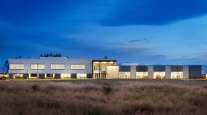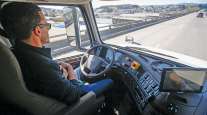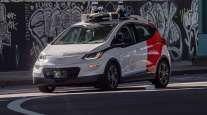Texas Official Wants Driverless Lanes on Interstate 35

Bexar County, Texas, Commissioner Kevin Wolff believes that a meeting he had last month in Washington with federal transportation officials could lead to construction of lanes for driverless automated vehicles on the Austin-San Antonio section of Interstate 35.
“This is the first proposal of its kind in the nation that I’m aware of,” Wolff said. “And when the feds heard about it, they told me, ‘This is just the kind of proposal we want to fund.’”
If it happens, it’ll take a while. The 95-mile stretch of eight-lane highway — perennially named one of the nation’s most congested traffic corridors — is already scheduled for an $8 billion expansion to add four “managed lanes” around 2025, according to the regional Alamo Metropolitan Planning Organization, or MPO, which Wolff chairs.
Wolff wants to make two of those four lanes designed for driverless vehicles — one in each direction from the Williamson County line in far north Austin almost to downtown San Antonio.
He hopes his proposal can tap into an estimated $200 billion in President Donald Trump’s infrastructure funding initiative, already under fire by critics who say the president will pay for it by crippling other existing federal programs and steer its benefits to Republican-dominated states.
“Department of Transportation officials told me they have targeted about $20 billion of that total for ‘innovative’ transportation ideas,” Wolff said. “And when they heard I wanted driverless lanes on I-35, they acted like this is common sense. They were receptive.”
RELATED: Waymo gets the OK for a commercial driverless ride-hailing service
Few doubt that the basic technology could be ready by 2025, though plenty of skeptics, including insurance companies, say it hasn’t yet proved that it can cope with the unpredictability of human drivers. Autonomous cars, they say, have a hard time figuring out how much rule-breaking is expected at, for example, a four-way stop or a left turn against traffic as the light is turning red.
Wolff was not surprised that federal officials were publicly noncommittal about the idea when reached last week.
A DOT spokesperson noted that the infrastructure proposal has yet to go to Congress and would only confirm that Wolff spoke with a government affairs officer, Chris Mitton, on Jan. 31 about “transformative projects” that might be suitable for future federal funding.
An added incentive, Wolff said, is that the normal 80-20 federal funding formula for highway projects, in which the state pays 80% and Washington pays 20%, would be reversed for projects that the DOT deems innovative.
“Logic tells me the technology will be there when we get around to building this,” said Wolff, who fought a years-long losing battle to bring a commuter rail system to the I-35 corridor.
RELATED: How cities in the San Francisco Bay area are paving the way for our autonomous car future
The Lone Star Rail project would have cost up to $3 billion but depended on the willingness — which was never forthcoming — of Union Pacific Railroad to lease its existing tracks. The driverless lanes would cost slightly more than the $4 billion estimated for two of the four managed lanes already planned, which includes acquiring new rights of way or elevating the new lanes where the interstate can’t be made any wider.
Will Conley, a former Hays County commissioner and chairman of the Capital Area MPO in Austin, said he thought Wolff’s proposal was “promising” and planned to push it and other ideas when he has his own talks with federal transportation officials. The notion of driverless freeways might not be that hard a sell, he said.
“Central Texas is a diverse place,” said Conley, who, like Wolff, is a Republican. “In my political experience, I don’t get 100% consensus on anything, but if this is presented the right way, an overwhelming number of my constituents would welcome an innovative approach to safety and traffic congestion.”
“I would love for Interstate 35 to have this national reputation as a corridor of innovation,” he added. “And wouldn’t it be nice if the symbol of all that was an automated major highway?”
RELATED: London not ready for driverless cars before 2030s, report says
Texas has built some of the nation’s most successful managed-lane highways — from tollways to high occupancy Vehicle lanes — and preparing I-35 for automated vehicles “makes perfect sense,” said Christopher Poe, assistant director for connected and automated transportation strategy at the Texas A&M Transportation Institute.
It would fit in nicely, Poe said, in a research region anchored by Texas A&M, San Antonio’s Southwest Research Institute and the University of Texas at Austin, where Google has been testing its Waymo automated vehicle on city streets for about two years.
Though the day when cars zip past New Braunfels and San Marcos while guided by invisible drivers might be a decade or more away, the infrastructure is not dramatically more expensive than conventional concrete highways, Poe said.
What’s more uncertain, he said, is how motorists would get from their homes to the driverless lanes and whether large numbers of people would be able to afford to buy automated vehicles, or if they would be cheap enough for short-term rentals. It might take something like Park and Ride facilities or a new niche for ride-hailing services.
“Oh, the devil is always in the details,” said Chandra Bhat, professor of civil architectural and environmental engineering at UT-Austin and a researcher of human behavior in transportation. “There are about 250 million vehicles in the country today, and it might take 30 years before a substantial number of them are driverless.”
“But 30 years ago, did anyone think we would ever ban smoking in public buildings and restaurants? In a democracy, it is hard to say, ‘Thou shall not drive your manual vehicle.’” Bhat said. “There are so many things to work out about sharing, the pride of ownership and even how drivers would adjust from an automated section of highway back to a conventional one.”
Besides the question of how to make it available to anyone but the affluent, the unknowns include cybersecurity for the cars themselves, insurance and the accommodation of physically challenged drivers.
“We must figure all of this out,” Bhat said. “But Mr. Wolff’s proposal is a good start. And we must start somewhere.”
Distributed by Tribune Content Agency, LLC




